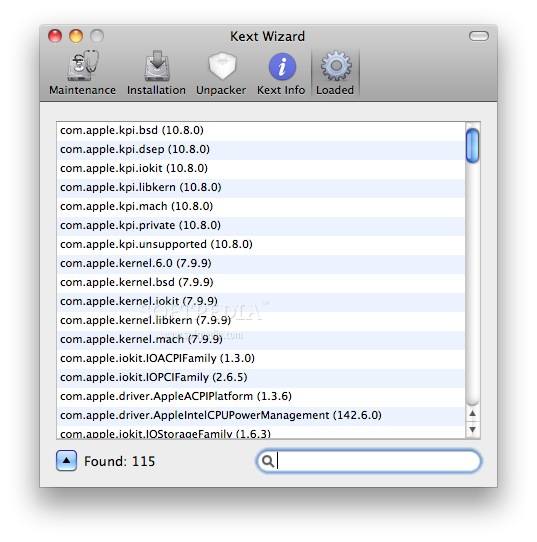OpenCore is what we refer to as a 'boot loader' – this is a complex piece of software that we use to prepare our systems for macOS – specifically by injecting new data for macOS such as SMBIOS, ACPI tables and kexts. How this tool differs from others like Clover is that it has been designed with security and quality in mind, allowing us to use many security features found on real Macs, such as SIP and FileVault. A more in-depth look can be found here: Why OpenCore over Clover and others
This guide specifically focuses on two main things:

If you have a Mac, you've probably at some point come across the need to install a Kext. Have a Mac, you've. Easy Kext installer that. Unpkg does not touch you system at all except for. Installing on macOS - Approving kext The macOS (10.13 High Sierra and later releases) makes sure that all installations are secure. It limits installation to only applications that are approved by Apple. To make sure your computer is protected. The post-installation is easier: By default, Hackintosh Mojave Installer will automatically install necessary Hackintosh-specific kexts and drivers for your computer when you boot your Mac OS X installation.
- Installing macOS on an X86-based PC
- Teaching you what makes your Hack work
Because of this, you will be expected to read, learn and even use Google. This is not a simple one-click install setup.

Please remember that OpenCore is still new and currently in beta. While quite stable, and arguably much more stable than Clover in pretty much every way, it is still being frequently updated, so chunks of configuration change quite often (i.e. new quirks replacing old ones).
Lastly, those having issues can visit both the r/Hackintosh subreddit and r/Hackintosh Discord for more help.
This contains a list of the kext files I use for my hackintosh. You may eventually need to update your kext files when new versions of macOS comes out for continued support.
Kext Locations:
- If using the Clover method I like to stuff my kexts in/EFI/CLOVER/kexts/Other
- If not you can place non-required kexts in /System/Library/Extensions
Required
These two kexts you should always have in your EFI partition.
FakeSMC.kext – Mantatory kext that emulates a Mac and is required to boot a hackintosh. When you download FakeSMC the folder will also contain Sensor kexts that you can use to monitor your hackintosh read about that here : HWMonitor Sensor Guide
Lilu.kext – Arbitrary kext that is required other kexts to work like AppleALC.kext & NvidiaGraphicsFixup.kext. Some Gigabyte motherboards have trouble with some versions of Lilu.kext breaking audio. I recommend those users use v1.0.0, instead of the latest version.
USB
USBInjectAll.kext – Injects all USB ports
XHCI-200-series-injector.kext – Enables USB 3 device detection and USB 3 speeds on Kaby Lake motherboards. This kext is also recommended to have during the macOS install process so you can use those USB 3 ports and flash drives.
Ethernet
IntelMausiEthernet.kext – Enables ethernet for motherboards using an Intel Ethernet Chipset.
RealtekRTL8111.kext – Enables ethernet for motherboards using a Realtek Ethernet Chipset
AtherosE2200Ethernet.kext – Enables ethernet for motherboards using Killer Lan Ethernet Chipset
Graphics
NvidiaGraphicsFixup.kext – Allows the latest Mac SMBIOS definitions to be used like iMac 17,x and iMac 18,x. You would want to use these SMBIOS defintions if you are using a Skylake or Kabylake CPU respectively. Updating to the latest version may fix black screen issues.
IntelGraphicsFixup.kext – Fixes display and graphical issues when using integrated graphics. I also recommend setting DVMT Pre-Allocated to 128M or higher in BIOS if using the Intel iGPU to enable high resolution displays.
WhateverGreen.kext – Enables AMD graphic cards in macOS 10.12.6 or later. Will require Lilu.kext. Read about it here : How to hackintosh AMD graphics cards in Sierra 10.12.6+
Shiki.kext – Protects against graphical issues with video playback
Audio
AppleALC.kext – Enables audio on a hackintosh. Read about how to enable audio here: Hackintosh Audio Guide. Some gigabyte users have problems with AppleALC.kext not enabling audio. I recommend them using v1.1.0, instead of the latest version.

HDMIAudio.kext – May help enable HDMI audio on some graphic cards. Read about it here : Hackintosh HDMI Audio + DisplayPort GFX Card Sound Guide
How To Install Kexts Mac
CodecCommander.kext – Fixes a problem with dim sounding or lower volume audio after sleeping/botting the hackintosh by updating EAPD (External Amplifier) state on HDA.
Spoofs
Install Kext Macos Catalina
FAKEPCIID.kext – Enables support for Intel processors on earlier versions of macOS that don’t support that processor by pretending to be a supported processor. Kaby Lake CPU’s are nativily supported as of macOS 10.12.6
FakePCIID_Intel_HD_Graphics.kext – Enables integrated graphics on iGPU’s that are not supported in macOS by mimicking another supported iGPU. Kaby Lake CPU’s with HD 630 are supported nativily in 10.12.6. If you have upgraded to 10.12.6 you can remove this kext.
Install Kext For Mac Catalina
NullCPUPowerManagement.kext – Used to enabled hackintosh support for Pentium Processors like the G4560
